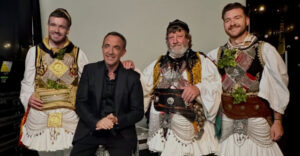The University Catholique de Louvain from Belgium continued its excavations in the monumental building with a central courtyard on Kefalari Sissi (Lassithi, Crete), dating back to the 16th century. B.C. The research was conducted under the auspices of of the Lasithi Ephorate of Antiquities and the Athens Belgian School with the assistance of experts and students from Greek and international universities. in conjunction with the
The Belgian School of Athens released a statement stressing that “the entire complex dates back to the neo-palatial period of the Minoan civilisation, around the 16th century. B.C. and was abandoned around the time of the eruption in Santorini, ashes of which were discovered inside the building. Beginning in 2015, it was finally possible to clean the central courtyard covered with mortar, which appears to have a maximum size of 16.50 x 33m”
It should also be noted that “several ceremonial installations were located above and along this central courtyard, which was directly accessible to the southwest by means of an elaborately covered aisle with corrugated walls”. The excavation revealed other large parts from the east and west wing of the complex, which also include a circular water collection cavity, which is connected to a water source.
Ask me anything
Explore related questions





